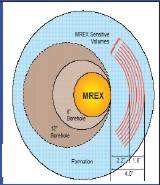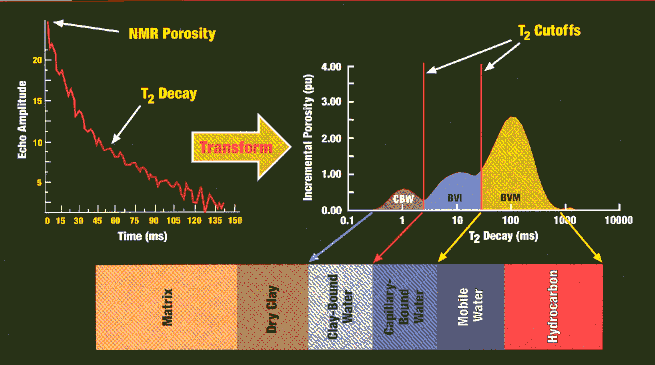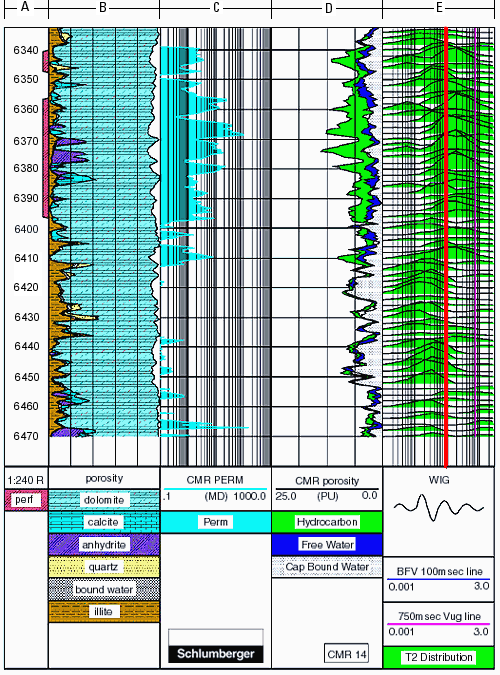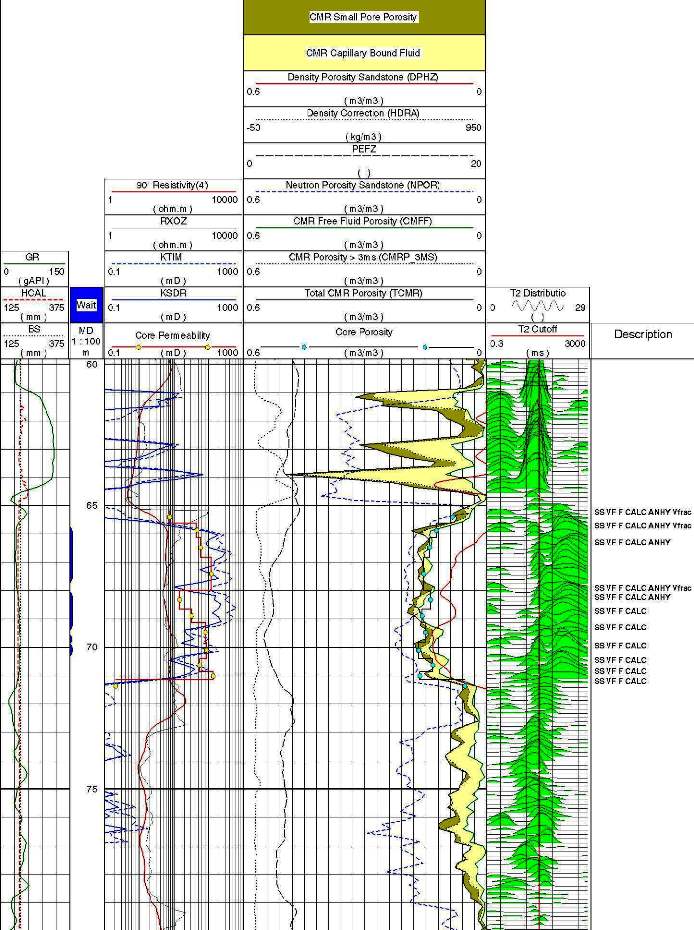|
 NMR LOG BASICS
NMR LOG BASICS
The chief application of the NMR tool is to determine
moveable fluid volume (BVM) of a rock. This is the pore space excluding
clay bound water (CBW) and irreducible water (BVI). Neither of these
are moveable in the NMR sense, so these volumes are not easily
observed on older logs. On modern tools, both CBW and BVI
can often be seen in the signal response after transforming the
relaxation curve to the porosity domain. Note that some of the
moveable fluids (BVM) in the NMR sense are not actually moveable in
the oilfield sense of the word. Residual oil and gas, heavy oil, and
bitumen may appear moveable to the NMR precession measurement, but
these will not necessarily flow into a well bore.
Micritic interparticle porosity and pin point vugs
in carbonates may be included in the CBW fraction. This may cause a
minor difference between effective porosity seen by conventional
logs and from NMR, especially in clean rocks in which some of the
porosity has very small pore size.
The NMR log has been around since the
early 1960's but it did not live up to it's hype until recently. As
a result the log is rare and previous bad experiences still get in
the way of its use today. Older logs attempted to measure the free
fluid index (FFI), equivalent to the modern tool's bulk volume
moveable (BVM).
With stronger magnets and better processing, modern
tools can usually give the irreducible water volume (BVI) and clay
bound water (CBW). Effective porosity (PHIe) is the sum of BVI and
BVM. In hydrocarbon zones at initial conditions, water saturation is
BVI divided by PHIe. No shale corrections or resistivity log are
needed.
The rock volume measured is very small compared to
density and neutron logs, so there is some possibility for
inconsistent results when comparing NMR porosity to these sources.
Unlike many other logging tools,
the NMR design and operating principles are somewhat different
between different service suppliers. A Schlumberger CMR tool
investigates a chunk of rock about the size of a good Cuban cigar,
about 1 inch from the borehole wall, in front of the permanent
magnet on the face of the tool. Halliburton's MRIL tool (NUMAR
design) measures a thin cylinder about 2 inches inside the rock,
circling the entire borehole. The Baker Atlas MREX tool sees a 120
degree segment of a cylinder about 2 inches into the rock.
 
Measured rock volume for MRIL (red circle), CMR (red dot), and MREX
(grey)
The NMR is now widely used in unconventional reservoirs as it is
immune to the effect of organic carbon (kerogen) so the effective
porosity from NMR needs no further correctiom, unlike sonic,
density, and neutron log porosity.

Transforming the precession decay time curve into the porosity
domain, showing breakdown of CBW,
BVI,
and BVM.
The T2 cutoff for the boundary between CBW and BVI is often chosen
at 3 ms. In sandstones, the boundary between BVI and BVM is usually
chosen at 32 or 33 ms, but in carbonates the cutoff could be much
higher (80 to 120 ms) and varies with lithology. The cutoffs can be
determined on rock samples in the lab.
References:
1. Effective Porosity and Permeability of
Sandstones Investigated Through Nuclear
Magnetic Resonance
Principles
A. Timur, SPWLA, 1968
 NMR LOG THEORY
NMR LOG THEORY
For modern NMR logs:
1: PHIt = PHIcbw + PHIbvi + PHIbvm
2: PHIe = PHIbvi + PHIbvm
3: PHIuse = PHIbvm
4: SWir = PHIbvi / PHIe
5: IF SW >> SWir
6: THEN zone will produce with a water cut
For older NMR logs:
7: PHInmr = FFI
8: SWir = KBUCKL / PHInmr
9: PHIe = FFI / (1 - SWir)
10: BVWSH = (PHINSH + PHIDSH) / 2
11: PHIt = PHIe + Vsh * BVWSH
IF PHIe is known from some other log:
12: PHIbvi = PHIe - PHInmr
13: SWir = PHIbvi / PHIe
 NMR LOG CURVE NAMES
NMR LOG CURVE NAMES
 Modern NMR Logs
Modern NMR Logs
|
Curves |
Units |
Abbreviations |
|
gamma
ray |
api |
GR |
|
* NMR
total porosity |
fractional |
PHITnmr |
|
NMR
effective porosity |
fractional |
PHIEnmr |
|
* NMR
clay bound water |
fractional |
PHIcbw |
|
NMR
irreducible water |
fractional |
PHIbvi |
|
NMR
moveable fluids |
fractional |
PHIbvm |
|
* NMR
permeability |
mD |
PERMnmr |
|
* NMR
pore size distribution |
|
|
| |
 Older NMR Logs
Older NMR Logs
|
Curves |
Units |
Abbreviations |
|
gamma
ray |
api |
GR |
|
free
fluid index |
fractional |
FFI =
PHIbvm |
Where:
FFI = free fluids or free fluid index (fractional)
PHInmr = NMR porosity (fractional)
PHIt = total porosity (fractional)
PHIe = effective porosity (fractional)
SWir = irreducible water saturation (fractional)
Vsh = shale volume (fractional)
BVWSH = bound water 100%in shale (fractional)
 EXAMPLES OF NMR LOGS
EXAMPLES OF NMR LOGS
A sample of a
modern NMR log is shown below. The depth scale (in feet) is at the
extreme left in column A. In the right hand track – column E – there
is a small graph at each depth illustrating the distribution of pore
sizes as deduced from the NMR measurements. Below 6410 feet almost
all the weight in the distributions is in small pores, as shown by a
green peak to the left of the red line. Above 6410 feet the weight
is predominantly in large pores, shown by a green peak to the right,
indicating a coarse-grained formation. Thus a geologist can look at
the NMR data and immediately recognize a change in rock texture at
an unconformity in a formation more than a mile underground.
A log of NMR-derived fluid
permeability is shown in Track 2 (column C). The permeability
changes by orders of magnitude in this section. In the fine-grained
formation, the permeability is negligible, while in the upper
coarse-grained section it is substantial. These results were used by
petroleum engineers to institute an efficient production program for
this well.

NMR sample log: Lithology analysis (Track1), NMR permeability (Track
2), NMR porosity
(Track 3 - white area = irreducible water volume BVI), NMR pore size
distribution (Track 4).

Nordegg tight oil shows large separation between the density (red
curve) and neutron porosity (black short dash), even though the sand
is clean according to the gamma ray log. The core porosity (blue
dots) and NMR total porosity (solid grey) are about halfway between
the two conventional porosity curves, which is where the Complex
Lithology model would also put the porosity. The PE (black heavy
dash) varies between 1.8 and 4.5 showing the variable nature of the
heavy mineral content.
NMR porosity is unaffected by organic carbon (TOC)
so it is a good log in shale gas environments. (image courtesy
Schlumberger)
|

